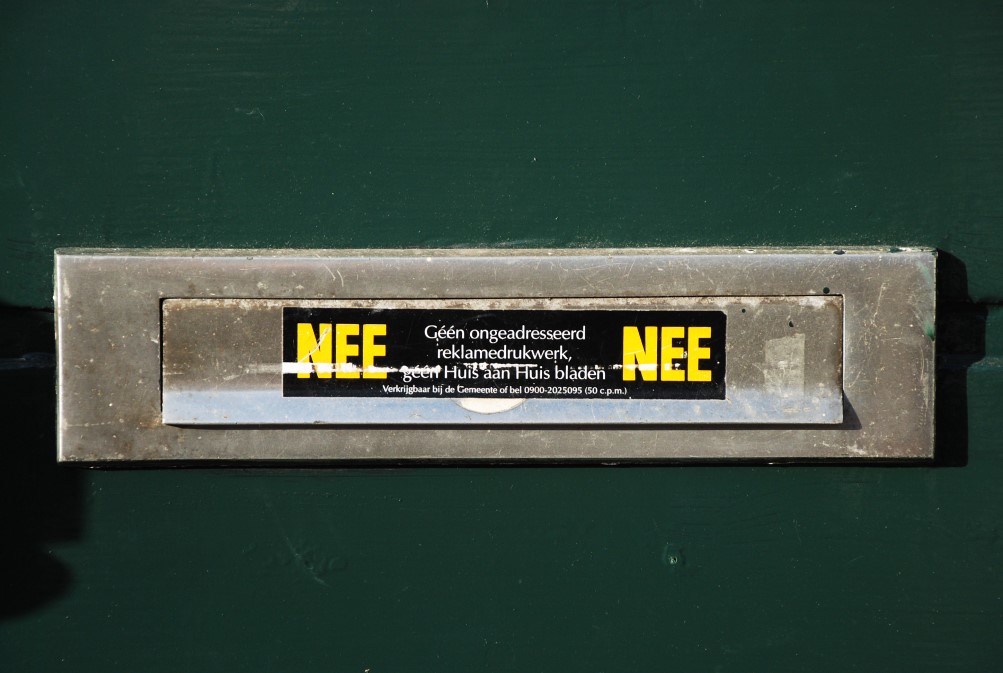Circular behaviour is easier if it is supported by policy
Yes, I was one of them. One of those people with the New Years’ resolution to live more sustainably. Last year I calculated my personal Earth overshoot day and that was a shock. So on New Year’s Eve, I shared my good intention (“As long as you don’t exaggerate,” my children shouted).
On 2 January, the best date to start your resolution, I ordered a sticker for my letterbox. That sticker will save me 33 kilos of advertising leaflets a year. This got me thinking: why do I have to make an extra effort to save money? Wouldn’t it be nice if people who do want to receive leaflets only have to order a Yes/Yes label to stick on their letterbox? That way, non-sustainable living would cost extra effort and not the other way round. The municipality of Amsterdam has done this and instead of 210,000 households, only 80,000 now receive thick packets of advertising leaflets every week. A nice saving, right? Then the question arise: “ Why has this not yet been introduced in all Dutch municipalities?”.
We are consuming ourselves to pieces
An additional advantage for me is that I am less greedy now that I no longer receive advertising brochures in my letter box. I no longer feel the need to run to the drugstore for that mega pack of toothpaste or to stock up at the supermarkets. But although the current lockdown and the lack of folders limit my buying behaviour, I notice that thinking about reducing consumption is difficult.
Fortunately, I can pick up Hans Dagevos’ plea for less pressure on consumption (in Dutch). According to Hans, we are consuming ourselves to pieces. Through our consumption behaviour we have pushed back the limit of what we consider ‘excessive consumption’ and so we, as humanity, contribute enormously to ‘the reckless transgression of ecological limits’. He has a point there. Although we in Europe agree that the circular bioeconomy is the way forward, we will never succeed in living within the limits of our beautiful planet if we continue to consume more and more.
If we want to live more sustainably, we must not only put all our energy into the circular design of products, think about origin of our food, and manners to save energy. We also need to limit our unlimited consumption: buy less stuff, share more stuff, travel less and ask ourselves why we allow shipping containers full of cheap stuff to come here via long shipping routes.
Circular agrifood system is a good basis
Now I do think about this because of my New years’ resolution and I do try to make sustainable choices. Yet it is so much easier if we do this together, supported by sustainable policies. This means that we should not only commit ourselves to a circular economy, but also politically and socially to policy initiatives and lifestyles that reduce consumption.
The Netherlands has already laid a good foundation for this by introducing circular agrifood systems. After all, circular agriculture is not only the answer to the sustainability challenge for agriculture, but also to a range of other challenges. It strengthens the position of the farmer in the chain, restores confidence in food production, creates synergy between agriculture and biodiversity, contributes to climate adaptation, prevents food waste, reduces emissions of CO2 and other greenhouse gases, is good for animal welfare and prevents essential raw materials from running out (Termeer, 2019).
Is there such a thing as ‘circular behaviour’?
What if we expand the concept of circular agriculture by linking it to limiting overconsumption – that can be overconsumption of food, but also of e.g. textiles? The report Circular Challenges (in Dutch) makes this link. A striking statement from this report: the Dutch ‘polder model’ is perhaps not the best policy route to make the transition to a sustainable circular economy.
In the report, the authors also address the question of whether there is such a thing as ‘circular behaviour’. A first sketch of this concept describes it as behaviour that is less calculating-controlling and more impulsive-innovative. It is important enough to explore the concept further, because it can help to stimulate and facilitate the circular behaviour of farmers, chain parties and consumers in terms of policy. Perhaps all those unaddressed advertising leaflets will then only be delivered to people with a Yes/Yes sticker on their letterboxes throughout the Netherlands. And it will be even easier for me to keep to my resolution.
 At the Circling Back symposium in November 2022, WUR will provide an overview of the results of four years of research. More than 50 researchers from all WUR Science Groups collaborated to gain new insights towards a circular, biobased society: ‘Connected Circularity’. Many stakeholders were involved in support for the transition to a circular bioeconomy, from small entrepreneurs at a local level to system partners at a global level. We worked with four so-called ‘Flagships’ in order to translate insights and tools in the field of circularity into practice. Read more.
At the Circling Back symposium in November 2022, WUR will provide an overview of the results of four years of research. More than 50 researchers from all WUR Science Groups collaborated to gain new insights towards a circular, biobased society: ‘Connected Circularity’. Many stakeholders were involved in support for the transition to a circular bioeconomy, from small entrepreneurs at a local level to system partners at a global level. We worked with four so-called ‘Flagships’ in order to translate insights and tools in the field of circularity into practice. Read more.
Note: the reports and publications to which I refer are from the project Governance in transitions, part of the knowledge base programme Circular and climate neutral of Wageningen University & Research.



Yes, I fully agree with the statement that we need more policy to get the circular agrifood production going. Especially in the transition phase from mainstream agriculture to the circular / regenerative agriculture support is needed to discourage old methods and to stimulate the new. Circular or even better regenerative agriculture should become mainstream very quickly. Will that happen in the current political climate? I doubt that. Not when the green parties can only be found in the left wing of the political arena. Green needs to be fully supported from all sides of the political arena…left right and center. Isn’t it time for a green right movement of in politics?